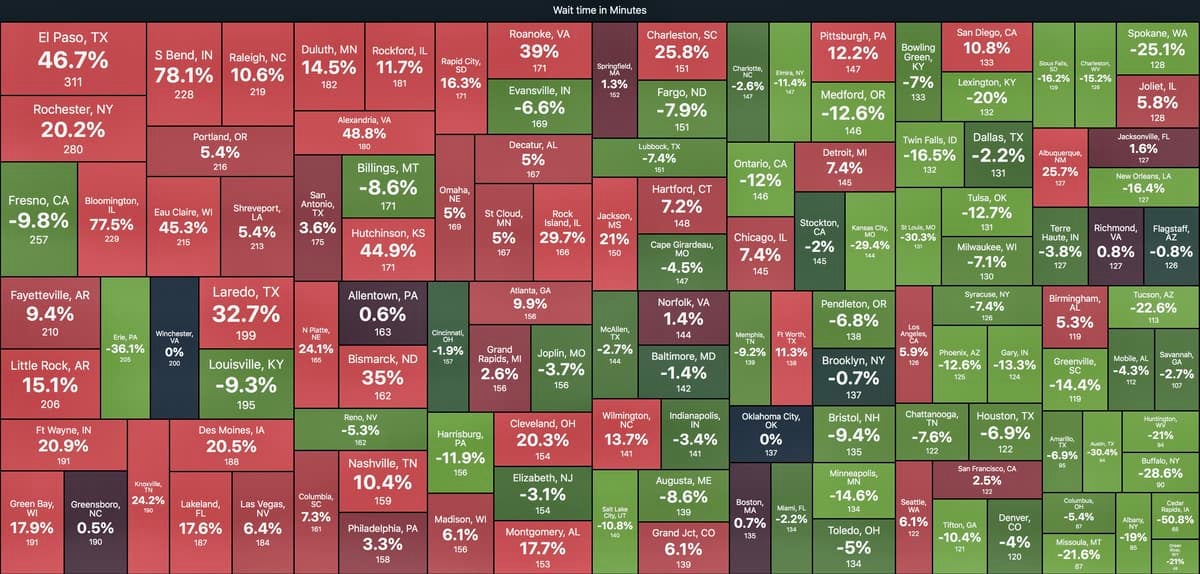Truck wait times at ports of entry along the United States-Mexico border are up, from El Paso, Texas, to Otay Mesa, California.
Industry professionals said the longer wait times are a combination of truckers spending more time waiting to load and unload freight at docks and intermodal facilities, as well as slower border inspection routines from agents with the Mexican National Guard and U.S. Customs and Border Protection.
Trucks moving freight between the Mexico-U.S. border at Otay Mesa crossing port near Tijuana and San Diego have been waiting up to five hours, according to customs officials.
“The carriers have been really rallying together because the lines have been one or two miles long – they really have been backing up,” said Myrna Aguilar, president of the San Diego Customs Brokers Association.
Aguilar said the longer waits had to do with truck volume being consistently high and CBP being slower in its inspections.
Everything from electronics, cars, car parts to medical devices are manufactured in Mexico, then imported into the U.S. through the Otay Mesa border crossing.
Otay Mesa Port of Entry has up to 10 commercial lanes operating from 6:00 a.m. to 8:00 p.m., but the CBP is only operating nine lanes right now, Aguilar said.
“There is no peak time for trucks anymore; the volume of trucks is steady all the time, from open to close,” Aguilar said. “When carriers get backed up, it affects everything.”
Customs officials on the Mexican side of the border near Otay Mesa said longer lines are causing Mexican commercial trucks to wait as long as five hours to cross into the U.S.
“The carriers themselves report to us that when they arrive at the [checkpoint] they are taking longer,” said Salvador Díaz González, president of the Tijuana-based Industrial Association of Otay Mesa (AIMO) in an August 14 report from elimparcial.com.
Truckers are also spending more time waiting to load and unload freight, according to FreightWaves SONAR, which now has data highlighting the best and worst-performing freight markets.

El Paso was one of the worst performing freight markets in the U.S. – 46 percent slower in July, compared to June. Wait times were as long as 311 minutes or more than five hours waiting at distribution centers and shipper warehouses, according to monthly averages.
Port Laredo wait times were also up 33 percent for the month of July, to 199 minutes (more than three hours), compared to the prior month.
However, Daniel Day, a truck driver based in Laredo, said he has not noticed any significant uptick in wait times.
“With dry trailers, loading is really quick,” Day said.
Day said he doesn’t driver reefer trucks, which probably accounts for some of the longer wait times in Laredo.
Day said another factor that could be slowing down freight trucks in Laredo is that importing cargo from Mexico, as part of the North American Free Trade Agreement (NAFTA), “Mexican truckers can operate within a trade zone, generally 50 miles from the border crossing, delivering their goods within the United States.”
“Basically, if a Mexican driver delivers within [50] miles to the border, either side whichever carrier you go to these ports, you drop the load or warehouse or something, Day said. “I have heard that sometimes these transfers can take a lot of time.”
Not all U.S.-Mexico border ports showed an increase in wait times.
Wait times decreased almost 3 percent at the U.S.-Mexico border crossing near McAllen, Texas, which includes the Pharr-Reynosa International Bridge.
In Tucson, Arizona, which includes the Nogales Port of Entry, wait times decreased by almost 23 percent for the month of July, compared to the previous month.











Anamoah Bismark
Good morning sir/madam my name is Anamoah Bismark
I am 43 year old .I am from Ghana
I completed national vocational training as a Driver
Machine in 1999.